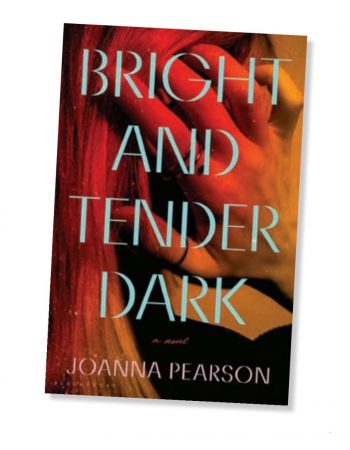OMNIVOROUS READER

More Than a Mystery
Murder haunts a college town.
By Anne Blythe
The makings for an ordinary crime thriller are present in Joanna Pearson’s first novel, but Bright and Tender Dark is anything but ordinary.
In the first few pages, Karlie, an alluring and enigmatic college student, is found dead in an off-campus apartment, brutally murdered, with no clear trail to the suspect. A former busboy with an eighth-grade education is in prison, conveniently convicted of her murder and serving time for a crime that shattered the tranquility of a college town.
The whodunnit aspect is there.
Joy, Karlie’s freshman year roommate and Pearson’s complicated protagonist, thinks the justice system got the wrong man. It is through Joy’s hunt for the real killer that we quickly realize Pearson’s book is a bit different from the traditional murder mystery. Layered on top is a retrospective investigation into the psychological ripple effects that Karlie’s dark death has had on the whole community, connecting seemingly unconnected people even two decades after it happened.
Pearson, a psychiatrist who lives in the Chapel Hill-Carrboro area, is also a poet and short story writer who now can add literary crime fiction to her compilation of writing genres. Just as her short story collections show that her poetic style spans literary genres, Bright and Tender Dark shows that her storytelling skills extend beyond short stories to novels. Many of the chapters could stand alone as stories within the larger story.
Pearson is masterful at character building. We meet Joy in the throes of middle age. She’s a mother of two finding a new footing after a painful divorce, assessing and reassessing her life. That evaluation creates the springboard for bouncing between two critical times in her life: the present, in which her ex is about to become a father again with his new wife; and the past, for which she has a new obsession, a decades-old murder.
Part of her compulsion comes from an unopened letter that Joy’s teenage son, Sean, finds in a book of John Donne poetry he has borrowed for English class.
It’s from Karlie.
“The letter has made a long and improbable voyage through time after being tucked away and forgotten, never even opened,” Pearson writes. “A miracle. An artifact of an old-fashioned epistolary era. Sean hands the letter to Joy with the solemnity of someone who has grown up on Snapchat. Joy’s hands tremble at the sight of the familiar handwriting. She dare not open it.”
Joy had been taking long walks alone at night, unable to sleep. Words and phrases reverberated through her mind as it raced. “Constitutionally unhappy.” That’s how her husband had described her as their marriage was blowing up. It had been “oppressive” for him, he said.
“He made the unhappiness sound like the core feature of her personality,” Pearson writes. “A suffocating force. The way that Joy looked at the world, pinched and vigilant, bracing for fire ants, falling branches, and tax deadlines, rather than celebrations. But her unhappiness allowed her to get things done!”
Joy eventually musters the courage to open that letter from Karlie. It was written in December 1999, shortly before her death, and is filled with exclamation points and underlined words — Karlie’s “characteristic arbitrary overuse of emphasis” on full display. But the letter holds a clue, one that Joy has not seen in any of the coverage of Karlie’s death, a mention of a BMW that had been pulling up outside her apartment. In the letter Karlie wonders whether it was Joy, but Joy didn’t have a BMW, nor had she been following Karlie to her apartment. Now, nearly two decades later, Joy is determined to find out who it was.
The search takes her back to old haunts in Chapel Hill, where Joy and Karlie went to college and where Joy still lives. She spirals into the depths of internet conspiracy theorists and true-crime Reddit platforms.
Pearson introduces an intriguing cast of characters: the predatory professor who woos his female students; the mother of the man doing time for the crime; the transgender night manager of the apartment building where Karlie was killed; the teenage son of a police chief on the high school soccer team with Joy’s son; people in cult-like religious groups; and more.
She takes her readers on a journey of discovery, giving them a glimpse of each character’s flaws and leaving open the possibility that they might be the killer, while also revealing clues that raise doubts about their potential guilt.
For anyone aware of high profile murders in Chapel Hill over the past couple of decades, there might seem to be some similarities with the 2012 killing of UNC sophomore Faith Hedgepeth and the 2008 death of UNC student body president Eve Carson. But at readings and in published interviews, Pearson has said the book is not based on a true crime. It’s fiction, although as a writer and engaged resident in the area, Pearson acknowledges that she cannot escape true events that continue to haunt the community. Writers write what they know.
Readers will appreciate Pearson’s adroit descriptions of Chapel Hill, places both real and imagined. She takes you onto campus, inside its buildings, and across its many grassy quads and wooded edges. Spots on Franklin Street and in downtown Carrboro are recognizable, as are near-campus neighborhoods.
As Pearson explores the mystery of an inexplicable crime in her novel, she also delves into the many mysteries of the mind. Her novel is a dark, yet tender and bright study of the void a death creates in a community, and the way people use that memory to make sense of themselves. OH
Anne Blythe has been a reporter in North Carolina for more than three decades covering city halls, higher education, the courts, crime, hurricanes, ice storms, droughts, floods, college sports, health care and many wonderful characters who make this state such an interesting place.
